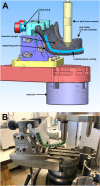Biomechanical In Vitro Study on the Stability of Patient-Specific CAD/CAM Mandibular Reconstruction Plates: A Comparison Between Selective Laser Melted, Milled, and Hand-Bent Plates
- PMID: 33995834
- PMCID: PMC8108099
- DOI: 10.1177/1943387520952684
Biomechanical In Vitro Study on the Stability of Patient-Specific CAD/CAM Mandibular Reconstruction Plates: A Comparison Between Selective Laser Melted, Milled, and Hand-Bent Plates
Abstract
Study design: An experimental in vitro study.
Objective: Plate fractures are a recurrent problem in alloplastic mandibular reconstruction. Hypothetically it can be assumed that computer-aided design (CAD)/computer-aided manufacturing (CAM) reconstruction plates have a higher stability than conventional hand-bent plates. The aim of the study was to compare additive and subtractive fabricated CAD/CAM mandibular reconstruction plates as well as conventional plates with regard to their biomechanical properties.
Methods: In a chewing simulator, plates of 2 conventional locking plate systems and 2 CAD/CAM-fabricated plate systems were compared. The plates were loaded in a fatigue test. The maximum number of cycles until plate fracture and the plate stiffness were compared.
Results: While all conventional plates fractured at a maximum load between 150 and 210 N (Newton) after a number of cycles between 40 000 and 643 000, none of the CAD/CAM plates broke despite a nearly doubled load of 330 N and 2 million cycles. Both CAD/CAM systems proved to be significantly superior to the hand-bent plates. There was no difference between the 2 CAD/CAM systems.
Conclusions: Concerning the risk of plate fracture, patient-specific CAD/CAM reconstruction plates appear to have a significant advantage over conventional hand-bent plates in alloplastic mandibular reconstruction.
Keywords: CAD-CAM; biomechanics; mandibular reconstruction; patient-specific implants.
© The Author(s) 2020.
Conflict of interest statement
Declaration of Conflicting Interests: The author(s) declared no potential conflicts of interest with respect to the research, authorship, and/or publication of this article.
Figures





Similar articles
-
CAD-CAM plates versus conventional fixation plates for primary mandibular reconstruction: A biomechanical in vitro analysis.J Craniomaxillofac Surg. 2017 Nov;45(11):1878-1883. doi: 10.1016/j.jcms.2017.08.024. Epub 2017 Sep 1. J Craniomaxillofac Surg. 2017. PMID: 28943180
-
Comparison of Modern Rigid Fixation Plating Outcomes for Segmental Mandibular Microvascular Reconstruction.Laryngoscope. 2019 May;129(5):1081-1086. doi: 10.1002/lary.27406. Epub 2018 Oct 3. Laryngoscope. 2019. PMID: 30284278
-
Computer-Assisted Mandibular Reconstruction using a Patient-Specific Reconstruction Plate Fabricated with Computer-Aided Design and Manufacturing Techniques.Craniomaxillofac Trauma Reconstr. 2014 Jun;7(2):158-66. doi: 10.1055/s-0034-1371356. Epub 2014 Feb 25. Craniomaxillofac Trauma Reconstr. 2014. PMID: 25045420 Free PMC article. Review.
-
Biomechanical evaluation of CAD/CAM magnesium miniplates as a fixation strategy for the treatment of segmental mandibular reconstruction with a fibula free flap.Comput Biol Med. 2024 Jan;168:107817. doi: 10.1016/j.compbiomed.2023.107817. Epub 2023 Dec 5. Comput Biol Med. 2024. PMID: 38064852
-
Multicenter study on the use of patient-specific CAD/CAM reconstruction plates for mandibular reconstruction.Int J Comput Assist Radiol Surg. 2015 Dec;10(12):2035-51. doi: 10.1007/s11548-015-1193-2. Epub 2015 Apr 7. Int J Comput Assist Radiol Surg. 2015. PMID: 25843949
Cited by
-
Computer-Assisted Surgery in Mandible Reconstruction.Semin Plast Surg. 2024 May 27;38(3):198-208. doi: 10.1055/s-0044-1786805. eCollection 2024 Aug. Semin Plast Surg. 2024. PMID: 39118858 Free PMC article. Review.
-
Accuracy Evaluation of an Alternative Approach for a CAD-AM Mandibular Reconstruction with a Fibular Free Flap via a Novel Hybrid Roto-Translational and Surface Comparison Analysis.J Clin Med. 2023 Mar 1;12(5):1938. doi: 10.3390/jcm12051938. J Clin Med. 2023. PMID: 36902725 Free PMC article.
-
Comparison of Laser-Sintered and Milled Patient-Specific Reconstruction Plates for Complications and Outcomes in Mandibular Defects-Comparative Analysis of a Single-Center Cohort.J Pers Med. 2023 Apr 9;13(4):648. doi: 10.3390/jpm13040648. J Pers Med. 2023. PMID: 37109034 Free PMC article.
References
-
- Baker A, McMahon J, Parmar S. Immediate reconstruction of continuity defects of the mandible after tumor surgery. J Oral Maxillofac Surg. 2001;59(11):1333–1339. - PubMed
-
- Linsen S, Schmidt-Beer U, Grüner M, Koeck B. CMD-Beschwerden bei Patienten mit Defekten im Kieferbereich. Dtsch Zahnaerztl Z. 2005;60:376–387.
-
- Bianchi B, Ferri A, Ferrari S, et al. Reconstruction of lateral through and through oro-mandibular defects following oncological resections. Microsurgery. 2010;30(7):517–525. - PubMed
-
- van Gemert JTM, van Es RJJ, Rosenberg AJWP, van der Bilt A, Koole R, van Cann EM. Free vascularized flaps for reconstruction of the mandible: complications, success, and dental rehabilitation. J Oral Maxillofac Surg. 2012;70(7):1692–1698. - PubMed
-
- Urken ML, Buchbinder D, Weinberg H, et al. Functional evaluation following microvascular oromandibular reconstruction of the oral cancer patient: a comparative study of reconstructed and nonreconstructed patients. Laryngoscope. 2015;125(7):1512. - PubMed
LinkOut - more resources
Full Text Sources
Miscellaneous
